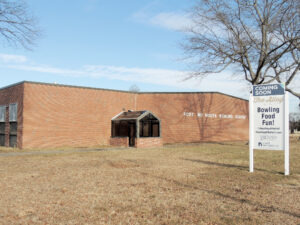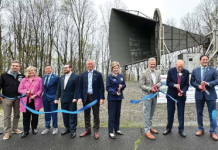
By Laura D.C. Kolnoski
FORT MONMOUTH – Speculation became reality Jan. 19 when the Fort Monmouth Economic Revitalization Authority (FMERA) unanimously voted to incorporate the fort’s former Bowling Center into its Mega Parcel offering. The agency will issue a new Request for Offers to Purchase for the now 292-plus-acre property. The adjustment is expected to delay the process by at least three months.
Parker Creek Partners of Rumson originally acquired the 2.8-acre Bowling Center property from FMERA in March 2021. After several requests for extensions of the project’s timeline and completion date, the firm notified the agency in September it no longer intends to pursue its redevelopment plans. Reasons given included COVID-19-related supply chain issues that caused construction delays and cost increases, and ongoing public health concerns that could impact operations. Voting FMERA members unanimously agreed to buy back the property for $1 at their December monthly meeting.
FMERA’s legal team, which includes the State Attorney General’s office, advised the board to incorporate the bowling center property into the Mega Parcel.
Some reasoning suggested, due to its location in the middle of the Mega Parcel, if the property had been placed back on the market as a separate tract, a speculator would purchase it in an attempt to flip it to the eventual Mega Parcel buyer for an inflated price.
The result was the termination of the original Request for Offers to Purchase the Mega Parcel issued last October, for which bids were due Jan. 31, and the creation of a new RFOTP that is now being finalized. No proposals have been submitted to date. Details of the new RFOTP will be available on the FMERA website – fortmonmouthnj.com – in the coming weeks.
In recommending the action, FMERA staff wrote, “…terminating the current RFOTP to allow for the expansion of the Mega Parcel offers the highest potential for success on all relevant parcels” and further supports the “highest and best use” of the 1,126-acre fort’s remaining acreage.
Staff further noted the bowling center can be demolished, but also “could be incorporated into a large scale, mixed-use development as a complementary amenity. FMERA believes that a robust, yet flexible approach to the Mega is the most advantageous strategy to attract new investment and incentivize development.”
Although Fort Monmouth spans portions of Eatontown, Oceanport and Tinton Falls, the Mega Parcel along Route 537 through the fort only includes portions of Eatontown and Oceanport. Jay Coffey, mayor of Oceanport, made the motion to include the bowling center during FMERA’s meeting held via teleconference. The motion was seconded by Eatontown Mayor Anthony Talerico. Robert Lucky, FMERA chairman, noted that the meeting drew the largest number of call-in listeners since FMERA meetings went remote in early 2020.
“My hope and belief is that we will get multiple bids,” said FMERA executive director Bruce Steadman. “That sets up a competitive process that is transparent and open, and harder to refute.”
Netflix confirmed its interest in the property in October after The Two River Times reported in July that the company responded to outreach by Gov. Phil Murphy aimed at bringing major media production companies to New Jersey.
The new RFOTP retains most of the original’s language, including allowed uses – life sciences, information and high tech, clean energy, food and beverage, and film and digital media. The Mega Parcel’s redevelopment is envisioned to align with the governor’s economic plan to “bolster the innovation economy” to create more jobs and further revitalize the 100-year-old U.S. Army base. An estimated 5,000 civilians lost their jobs when the fort closed.
The Housing Component
The Reuse Plan for Fort Monmouth was established a decade ago, including the amount of residential housing to be created throughout the three towns – 1,585 units with 20 percent designated for affordable housing – amounting to about 320 units. Some has already been built and occupied.
But residential housing might not be part of the plans of any potential proposers of the Mega Parcel. FMERA addressed this issue in documents released Jan. 19. Proposals including alternate uses would require an amendment to the Reuse Plan, officials said.
The maximum number of residential units is currently 302 in Eatontown and 235 in Oceanport. Proposals exceeding those caps would also be deemed noncompliant.
“Residential development is not a requirement of the RFOTP,” staff wrote. “If the selected potential purchaser does not include housing in (its) proposal, a Reuse Plan Amendment must identity alternate locations for housing.”
Steadman noted all redevelopment plans are subject to local zoning ordinances. Developers must bring their plans before the local zoning boards and governing bodies as part of the standard multilevel approval process.
At the FMERA level, proposals are evaluated based on established criteria and scored on a points basis with a final recommendation presented to voting members for approval, followed by approval processes at other state agencies, the county and the municipalities.
“There will have to be a serious discussion on how to meet the housing requirements, we will evaluate all options, and it must make sense for the towns,” Tim Sullivan, CEO of the New Jersey Economic Development Authority, told The Two River Times. “Having a mix of uses at the fort is important. We have the same commitment to affordable housing. We will see how the submissions come in. The goal is to bring as many jobs as possible back to Fort Monmouth. That has been the strategy all along.”
Sullivan also confirmed that “a handful” of EDA employees will begin working out of FMERA offices in the fort’s former library, potentially by spring. “This will allow more flexibility for our workforce,” he said. “People can work closer to their homes.”
The move is also expected to allow better compliance with social distancing and other COVID-19 prevention measures.
The article originally appeared in the January 27 – February 2, 2022 print edition of The Two River Times.














